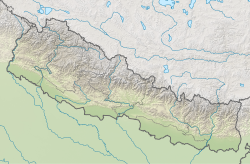Kathmandu Valley
The Kathmandu Valley (Nepali: काठमाडौं उपत्यका, Newar: स्वनिगः, नेपाः गाः), historically known as Nepal Valley or Nepa Valley, lies at the crossroads of ancient civilizations of South Asia and the broader Asian continent, and has at least 130 important monuments, including several pilgrimage sites for Hindus and Buddhists. The valley comprises of 3 districts that are Kathmandu, Bhaktapur, and Lalitpur, all having the combined population of about 5 million people. [2]There are seven World Heritage Sites within the valley.[3][4]
| UNESCO World Heritage Site | |
|---|---|
 Kathmandu valley seen from Palanse, Bhaktapur | |
| Location | Province No. 3, Nepal |
| Reference | 121bis |
| Inscription | 1979 (3rd Session) |
| Extensions | 2006 |
| Endangered | 2003–2007[1] |
| Area | 167.37 ha (413.6 acres) |
| Buffer zone | 70.29 ha (173.7 acres) |
| Coordinates | 27°42′14″N 85°18′31″E / 27.70389°N 85.30861°E |

Historically, the valley and adjoining areas made up a confederation known as the Nepal Mandala. Until the 15th century, Khwopa was its capital, when two other capitals, Kathmandu and Yala, were established.[5] After the annexation of the valley by the Gorkha Kingdom, and subsequent conversion of the Valley as the capital of their empire, the designation of "Nepal" was extended to all the lands they had conquered.
Related pages
changeReferences
change- ↑ Royal Palaces of Abomey and Kathmandu removed from Danger List at UNESCO website
- ↑ Mission Himalaya, Treks. "Kathmandu Valley".
- ↑ Centre, UNESCO World Heritage. "Kathmandu Valley". whc.unesco.org. Retrieved 8 September 2018.
- ↑ Rajendra S. Khadka Travelers' Tales Nepal
- ↑ Slusser, Mary (1982). Nepal Mandala: A Cultural Study of the Kathmandu Valley. Princeton University. ISBN 978-0-691-03128-6. Page vii.
